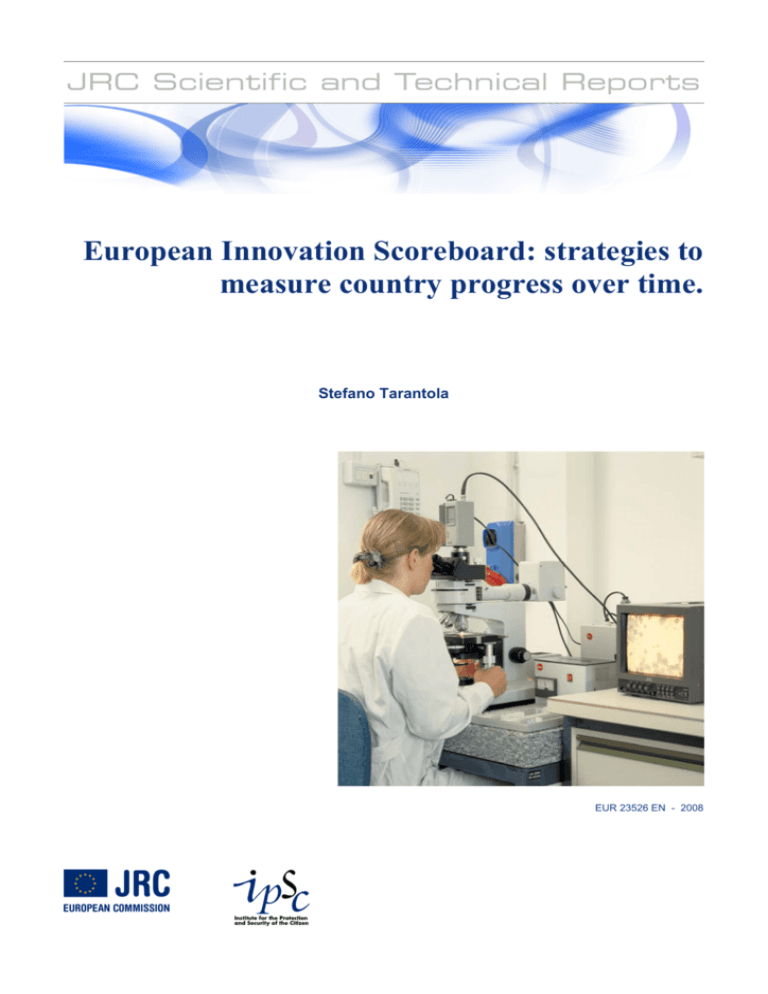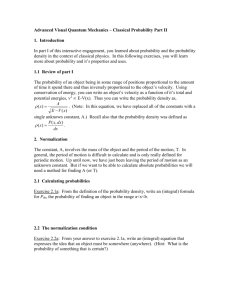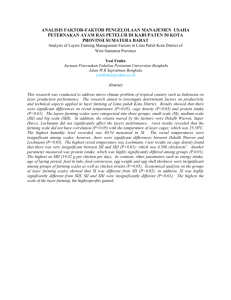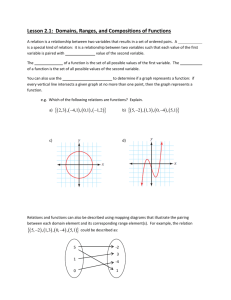European Innovation Scoreboard: strategies to measure country
advertisement

European Innovation Scoreboard: strategies to
measure country progress over time.
Stefano Tarantola
EUR 23526 EN - 2008
The Institute for the Protection and Security of the Citizen provides research-based, systemsoriented support to EU policies so as to protect the citizen against economic and technological
risk. The Institute maintains and develops its expertise and networks in information,
communication, space and engineering technologies in support of its mission. The strong crossfertilisation between its nuclear and non-nuclear activities strengthens the expertise it can bring
to the benefit of customers in both domains.
European Commission
Joint Research Centre
Institute for the Protection and Security of the Citizen
Contact information
Address: T.P. 361 Via E. Fermi, 2749 – 21027 Ispra (VA) - ITALY
E-mail:
stefano.tarantola@jrc.it
Tel.:
+39 0332 789928
Fax:
+39 0332 785733
http://ipsc.jrc.ec.europa.eu/
http://www.jrc.ec.europa.eu/
Legal Notice
Neither the European Commission nor any person acting on behalf of the Commission is
responsible for the use which might be made of this publication.
Europe Direct is a service to help you find answers
to your questions about the European Union
Freephone number (*):
00 800 6 7 8 9 10 11
(*) Certain mobile telephone operators do not allow access to 00 800 numbers or these calls may be billed.
A great deal of additional information on the European Union is available on the Internet.
It can be accessed through the Europa server http://europa.eu/
JRC 46943
EUR 23526 EN
ISSN 1018-5593
Luxembourg: Office for Official Publications of the European Communities
© European Communities, 2008
Reproduction is authorised provided the source is acknowledged
Printed in Italy
Introduction......................................................................................................................... 2
1 Re-scaling approaches ..................................................................................................... 3
1.1 Current procedure of indicization ............................................................................. 3
1.2 Current procedure of normalization.......................................................................... 3
1.3 The z-scores normalisation method .......................................................................... 7
1.3.1 An alternative approach ..................................................................................... 7
1.4 Composite indicator formula .................................................................................... 8
2 Calculating growth rates .................................................................................................. 9
2.1 Growth rate of a composite indicator........................................................................ 9
2.2 The rate of change of a composite indicator........................................................... 12
2.3 Composite growth rates .......................................................................................... 13
2.4 A generalised formula for the composite growth rates........................................... 13
2.5 Distance to target .................................................................................................... 15
3 Conclusions.................................................................................................................... 16
Acknowledgements........................................................................................................... 16
References......................................................................................................................... 16
1
Introduction
In the following chapters we examine possible alternatives to the current approach used in the
European Innovation Scoreboard (EIS) to measure country progress in innovation performance
over time. The quantitative approach used to assess country performance is the Summary
Innovation Index. The methodology to calculate the SII scores and the SII growth rates is
explained in the technical annex of the EIS 2007 report, therefore it is not reported here.
We briefly recall the basic steps to calculate the SII growth rate. The SII growth rate is based on
the SII values over a 5-year period. Such SII values are calculated using the min/max
normalization technique (see below), using the overall minima and maxima scores across the full
5 years and across the EU27 + EFTA countries for each component indicator. Moreover, some
identified outliers have been excluded from the calculation of the minima and maxima.
Finally, as the EIS report says, <<… the growth rate of the SII is calculated as the annual
percentage change between the SII at time t and the average over the preceding three years, after
a one-year lag (i.e., t-4, t-3 and t-2). The three-year average is used to reduce year-to-year
variability; the one-year lag is used to increase the difference between the average for the three
base years and the final year and to minimize the problem of statistical / sampling variability.>>.
In the first part of this report we examine whether available re-scaling approaches (i.e.
indicization and normalization) are compatible with the formulas for the calculation of SII growth
rates. So, we will revisit both min/max normalization and z-scores techniques and analyze their
feasibility for the subsequent calculation of SII growth rates. In the second part, we will focus on
the different ways to calculate growth rates, and the different meanings of the corresponding
outcomes. We provide examples using the data available on the EIS 2007 Excel spreadsheet.
We do not recommend specific approaches, yet we highlight which combinations of indicization,
normalization and growth rate calculation should be avoided.
The focus of the report is to raise discussion among the participants to the workshop of June 16,
2008 upon the relative merits and limitations of these approaches, with the idea to identify
potential candidates for further improvements of the SII. The report is an overview of approaches
that are in principle applicable to any given dataset. The report is not a feasibility study of a
specific technique to the EIS dataset, for which more detailed analyses would be required given
the constraints dictated by the quality of the dataset, including the presence of missing values.
2
1 Re-scaling approaches
By re-scaling we mean any algebraic transformation of the indicators’ raw values that is useful
for preparing the indicators to the subsequent weighting/aggregation. In particular, we examine
indicization and normalization.
1.1 Current procedure of indicization
An indicization transforms the raw values into values that are related to a reference index of, say,
100. We revisit the current indicization procedure used in the SII for the component indicators.
At present, for a given country c, the value y ic of indicator i is divided by the value of the same
indicator for EU 27 (i.e. yiEU ) and multiplied by 100 in order to obtain an indicized value.
z ic = 100
y ic
y iEU
(1)
If the indicized value is 100 it means that the indicator for that country performs as the EU27. If
the indicized value is larger than 100, it means that the country performs better than the EU27.
With this type of indicization, which is repeated independently for each year of analysis, it is not
possible to appreciate any absolute change in country performance, as the values have all been
relativized to EU27. So, if we want to quantify absolute changes in performance over time we
have to consider this process with care (see discussion in section 1.5).
1.2 Current procedure of normalization
In addition, the current approach used to normalize the component indicators in order to build the
SII consists in normalizing the scores of each indicator z ic by using the so-called min-max
normalization. This consists in subtracting the lowest indicator value found in the group of
countries z i ,min and then dividing by the difference between the highest z i , max and the lowest
z i ,min values found within the same group of countries:
xic =
z ic − z i ,min
(2)
z i ,max − z i ,min
The maximum re-scaled score is equal to 1 and the minimum value is equal to 0.
To assess absolute changes in performance over time, the min-max normalization approach has to
be used with care. Given that the scores are available over a number of years z ict , the minimum
and the maximum values for each indicator across the countries have to be found across all the
years:
3
{ }
{z }
z i , Min = min ∀t ,∀c z it,c
z i , Max = max ∀t ,∀c
(3)
t
i ,c
These overall minimum z i , Min and maximum z i , Max have to be used for the normalization:
x =
t
ic
z ict − z i , Min
(4)
z i , Max − z i , Min
The overall minima and maxima of the indicators across years 2005, 2006 and 2007 are reported
in Table 1. These minima and maxima are calculated on the raw indicators y ic across all EU 27 +
EFTA countries, thus excluding HR, TR, US, JP, IL,CA and AU.
OVERALL
OVERALL
MIN
MAX
1.1
S&E graduates
1.2
Population with tertiary education
1.3
Broadband penetration rate
0.20
29.60
1.4
Participation in life-long learning
1.30
32.10
1.5
Youth education attainment level
49.00
96.20
2.1
Public R&D expenditures
0.17
1.17
2.2
Business R&D expenditures
2.3
Share of medium-high/high-tech R&D
2.4
3.1
1.80
24.50
10.44
35.14
0.08
2.93
68.12
92.72
Enterprises receiving public funding for innovation
0.32
39.31
SMEs innovating in-house
9.32
37.32
3.2
Innovative SMEs co-operating with others
2.83
20.77
3.3
Innovation expenditures
0.73
3.47
3.4
Early-stage venture capital
0.00
0.22
3.5
ICT expenditures
4.90
9.90
11.01
58.43
3.6
SMEs using organizational innovation
4.1
Employment in high-tech services
1.37
5.13
4.2
Exports of high technology products
2.35
55.90
4.3
Sales of new-to-market products
1.90
13.55
4.4
Sales of new-to-firm products
1.57
10.03
4.5
0.98
10.75
5.1
Employment in medium-high/high-tech
manufacturing
EPO patents per million population
1.17
425.64
5.2
USPTO patents per million population
0.00
167.49
5.3
Triad patents per million population
0.00
81.90
5.4
Community trademarks per million population
0.26
901.97
5.5
Community industrial designs per million
population
0.00
398.03
Table 1: overall minima and maxima of the raw indicators across years 2005, 2006 and 2007 for the EU27 +
EFTA countries.
When a new year of data becomes available, it may happen that the overall minimum or
maximum across countries, for one or more indicators, changes. In such case, if the indicators are
normalized using the existing overall maximum and minimum, it may be that some values are
below 0 or above 1. If this happens, the CI can still be computed and the comparability across
4
time is not affected. However, it is common practice to avoid this to happen; therefore, the overall
minimum and/or maximum are updated and the whole SII is recalculated across the past years. In
this way, the SII maintains comparability across time, yet the past values of the SII could have
changed.
In Figure 1, the SII calculated using the overall min/max normalization scheme across the latest
three years (data for 2004, 2005, 2006) is plotted against the classic SII values obtained with a
min/max normalization carried out for each year independently. It can be noticed that the SII
scores and rankings are quite stable to the generalization of the normalization scheme (only 0.02
maximum difference of scores in 2005, 0.03 in 2006 and 0.06 in 2007). In all years, the rankings
of few countries differ of 2, 3 positions as function of the normalization adopted (see for example
Australia and Estonia in Table 2.1, Iceland in Table 2.2, and Estonia, Norway, Slovenia in Table
2.3).
SII 2007
SII 2006
0.8
SII with overall min/max normalization
SII with overall min/max normalization
0.8
0.6
0.4
0.2
0.6
0.4
0.2
0
0
0
0.1
0.2
0.3
0.4
0.5
0.6
0.7
0.8
0
0.1
0.2
0.3
0.4
0.5
0.6
0.7
0.8
SII w ith annual m in/m ax norm alization
SII with annual min/max normalization
SII 2005
SII with overall min/max normalization
0.8
0.6
0.4
0.2
0
0
0.1
0.2
0.3
0.4
0.5
0.6
0.7
0.8
SII w ith annual m in/max norm alization
Figure 1. The SII calculated using the overall min/max normalization scheme across the latest three years
2005, 2006 and 2007 (data for 2004, 2005, 2006) is plotted against the classic SII values obtained with a
min/max normalization carried out for each year independently.
5
with overall
min/max
norm.
SE
0.71
CH
0.66
FI
0.62
JP
0.62
DK 0.62
IL
0.61
DE
0.57
LU
0.53
UK 0.52
US
0.52
IE
0.48
BE
0.47
NL
0.47
AT
0.47
FR
0.46
IS
0.45
CA
0.45
EU
0.42
AU 0.36
NO 0.36
SI
0.36
EE
0.35
CZ
0.34
IT
0.33
ES
0.30
CY
0.30
MT 0.29
EL
0.27
LT
0.25
HU 0.25
SK
0.24
PT
0.23
PL
0.23
BG
0.22
HR
0.21
RO
0.18
LV
0.18
TR
0.04
with annual
min/max
norm.
SE
0.73
CH
0.67
FI
0.63
JP
0.62
DK
0.62
IL
0.61
DE
0.57
LU
0.55
UK
0.53
US
0.52
IE
0.48
BE
0.47
NL
0.47
AT
0.46
IS
0.46
FR
0.46
CA
0.44
EU
0.42
EE
0.36
NO
0.35
AU
0.35
SI
0.35
CZ
0.34
IT
0.32
CY
0.30
ES
0.29
MT
0.28
LT
0.26
EL
0.25
HU
0.25
SK
0.23
PT
0.22
PL
0.22
BG
0.22
HR
0.21
LV
0.18
RO
0.18
TR
0.04
Table 2.1: Country scores
and rankings for SII for year
2005 with annual and overall
min/max normalization
with overall
min/max
norm.
SE
0.69
FI
0.63
CH
0.63
DK 0.60
IL
0.60
JP
0.60
DE
0.57
LU
0.54
UK 0.52
US
0.50
IE
0.48
BE
0.47
AT
0.46
FR
0.46
NL
0.46
IS
0.45
CA
0.43
EU
0.42
NO 0.36
SI
0.36
EE
0.35
AU 0.35
CZ
0.35
IT
0.33
CY
0.31
ES
0.31
MT 0.30
LT
0.27
EL
0.26
HU 0.25
SK
0.25
PT
0.25
PL
0.24
BG
0.23
HR
0.20
LV
0.19
RO
0.18
TR
0.05
with annual
min/max
norm.
SE
0.72
FI
0.65
CH
0.65
DK
0.62
IL
0.62
JP
0.61
DE
0.57
LU
0.56
UK
0.53
US
0.52
IE
0.48
BE
0.47
IS
0.47
AT
0.47
FR
0.47
NL
0.46
CA
0.43
EU
0.43
EE
0.37
NO
0.36
SI
0.35
AU
0.35
CZ
0.34
IT
0.32
CY
0.31
ES
0.30
MT
0.29
LT
0.27
EL
0.25
HU
0.25
PT
0.25
SK
0.24
PL
0.23
BG
0.22
HR
0.19
LV
0.19
RO
0.17
TR
0.05
Table 2.2: Country scores
and rankings for SII for year
2006 with annual and overall
min/max normalization
with overall
min/max
norm.
SE
0.74
with annual
min/max
norm.
SE
0.67
CH
0.67
CH
0.62
FI
0.64
FI
0.61
IL
0.62
JP
0.6
DK
0.61
IL
0.59
JP
0.61
DK
0.57
DE
0.59
DE
0.57
UK
0.57
UK
0.52
LU
0.54
LU
0.51
US
0.52
US
0.49
IE
0.49
IE
0.48
IS
0.48
AT
0.47
AT
0.48
NL
0.46
NL
0.48
IS
0.45
FR
0.47
BE
0.45
BE
0.47
FR
0.45
EU
0.46
CA
0.42
CA
0.43
EU
0.42
EE
0.37
CZ
0.36
NO
0.36
SI
0.36
CZ
0.36
AU
0.35
AU
0.36
EE
0.35
SI
0.35
NO
0.35
IT
0.33
IT
0.33
CY
0.33
CY
0.32
ES
0.31
ES
0.3
MT
0.29
MT
0.3
LT
0.27
EL
0.27
HU
0.26
LT
0.27
EL
0.26
HU
0.26
PT
0.25
SK
0.25
SK
0.25
PL
0.24
PL
0.24
PT
0.24
BG
0.23
BG
0.23
HR
0.2
HR
0.2
LV
0.19
LV
0.19
RO
0.18
RO
0.18
TR
0.05
TR
0.05
Table 2.3: Country scores
and rankings for SII for year
2007 with annual and overall
min/max normalization
6
1.3 The z-scores normalisation method
An alternative approach to normalise the indicators can be used to assess absolute changes in performance over
time. This approach is called z-scores and has been applied, for instance, by DG-RTD to develop their
composite indicators of knowledge-based economy. With a view to allow comparisons between years, the raw
0
values y ict of each indicator i for country c at time t are standardised using their mean yiEU
and their standard
0
deviation σ iEU
across the European countries (excluding the EU aggregate) for the reference year t=0.
xict =
0
yict − yiEU
(5)
0
σ iEU
The advantage of this method as opposed to the min-max method is that we do not need to update the
normalisation parameters when a new year of data becomes available, given that the EU mean and standard
deviation are constant and, therefore, no recalculation of the SII is required.
The results of the SII calculated with the z-scores normalization approach are reported in Table 3 for the years
2005, 2006 and 2007. Of course, EU in 2005 has zero score. We can appreciate the trend of each country across
the years as well as their relative position to the EU. For instance, Italy in 2007 has the same score (hence
performance) of the EU average in 2005. Luxembourg has an extremely high value of the SII. This is due to the
very high value of the indicator ‘Community trademarks per million population’ for all years; we have not
corrected for this outlier as was done with the min/max normalization approach.
In Table 3 it is straightforward to appreciate the trend of each country over the three years and the relative
position with respect to the EU in 2005 (which has zero score). The absolute values of the SII are completely
different from the previous case where the min/max normalization is used. On the right side of the table the
normalization is carried out using formula 6. Here it is not possible to appreciate the time trend of each country
any more but it is possible to calculate the spread of the countries scores at a given year on the basis of their
standard deviations. Calculations show that the standard deviation is slightly increasing with time, meaning that
the countries performances tend to widen as time increases.
1.3.1 An alternative approach
t
An alternative approach is to use, for each year t, the corresponding mean value y iEU
while maintaining the
0
standard deviation at its value of the reference year σ iEU
.
x =
t
ic
t
yict − yiEU
(6)
0
σ iEU
In this way, each indicator is standardised differently for each year; therefore, we can not appreciate the time
trend of the SII any more, but we get an indication of the spread of the countries SII’s at each time point. This
might be useful to measure the level of convergence of countries in innovation performance. In particular we
found that the standard deviation slightly increases with time, meaning that the countries performances tend to
widen as time increases.
7
SII with z-scores normalization
(formula 5)
SII with z-scores normalization
(formula 6)
2005
2006
2007
2005
2006
2007
EU
0.00
0.01
0.03
EU
0.00
0.00
0.00
BE
0.02
0.04
0.04
BE
0.02
0.03
0.01
BG
-0.25
-0.24
-0.23
BG
-0.25
-0.25
-0.26
CZ
-0.12
-0.11
-0.09
CZ
-0.12
-0.12
-0.12
DK
0.20
0.22
0.25
DK
0.20
0.21
0.22
DE
0.24
0.25
0.29
DE
0.24
0.24
0.26
EE
-0.13
-0.12
-0.10
EE
-0.13
-0.13
-0.14
IE
0.08
0.06
0.09
IE
0.08
0.05
0.06
EL
-0.18
-0.18
-0.17
EL
-0.18
-0.19
-0.21
ES
-0.16
-0.14
-0.13
ES
-0.16
-0.15
-0.16
FR
0.03
0.04
0.06
FR
0.03
0.03
0.02
IT
-0.04
-0.02
0.00
IT
-0.04
-0.03
-0.03
CY
-0.11
-0.09
-0.01
CY
-0.11
-0.10
-0.05
LV
-0.24
-0.22
-0.21
LV
-0.24
-0.23
-0.25
-0.20
LT
-0.19
-0.17
-0.16
LT
-0.19
-0.19
LU
0.43
0.60
0.61
LU
0.43
0.59
0.57
HU
-0.15
-0.15
-0.15
HU
-0.15
-0.16
-0.18
MT
-0.29
-0.28
-0.22
MT
-0.29
-0.29
-0.26
NL
0.13
0.13
0.16
NL
0.13
0.11
0.13
AT
0.14
0.14
0.20
AT
0.14
0.13
0.17
PL
-0.21
-0.19
-0.18
PL
-0.21
-0.20
-0.21
-0.22
PT
-0.24
-0.23
-0.19
PT
-0.24
-0.24
RO
-0.26
-0.34
-0.33
RO
-0.26
-0.35
-0.36
SI
-0.09
-0.10
-0.07
SI
-0.09
-0.11
-0.11
SK
-0.19
-0.18
-0.17
SK
-0.19
-0.19
-0.20
FI
0.21
0.23
0.24
FI
0.21
0.21
0.21
SE
0.26
0.28
0.32
SE
0.26
0.27
0.28
UK
0.08
0.09
0.12
UK
0.08
0.08
0.08
HR
-0.25
-0.25
-0.25
HR
-0.25
-0.27
-0.30
TR
-0.55
-0.54
-0.53
TR
-0.55
-0.56
-0.59
IS
-0.12
-0.11
-0.03
IS
-0.12
-0.13
-0.07
NO
-0.11
-0.11
-0.10
NO
-0.11
-0.12
-0.13
CH
0.40
0.41
0.50
CH
0.40
0.40
0.46
US
0.18
0.19
0.20
US
0.18
0.17
0.15
JP
0.24
0.24
0.25
JP
0.24
0.22
0.19
IL
0.21
0.21
0.21
IL
0.21
0.19
0.17
CA
-0.08
-0.07
-0.06
CA
-0.08
-0.09
-0.12
AU
-0.25
-0.25
-0.22
AU
-0.25
-0.26
-0.27
Table 3: SII obtained with the z-scores normalization approach and formula 5.
1.4 Composite indicator formula
Letting aside the problem of weights selection and discussions upon the choice of the aggregation rule (here we
simply use linear aggregation), which is not the focus here, the composite indicator I ct for country c at time t is
the sum of the m component indicators xict :
I ct = ∑i =1 wi xict
m
weighted by the coefficients wi , which are selected such that
∑
m
i =1
(7)
wi = 1 .
8
2 Calculating growth rates
Let us now come closer to the focus of this work, which is to propose some feasible options for assessing
changes in country performances over time. Once the composite indicator is calculated for a number of years, it
is easy to observe changes and trends in its values without going in too complex calculations. In this chapter we
define the growth rate of a composite indicator both in relative terms (as percentage change with respect to the
previous year or to a number of years in the past) and in absolute terms (the so called rate of change, as
difference between the CI score at present and the CI score a number of years in the past), as well as composite
growth rates, useful to provide complementary information (see section 2.3), and an approach to measure
growth based on distance to target (see section 2.5).
2.1 Growth rate of a composite indicator
Each country is, at any given time, characterised by a value of the composite indicator which can be compared
with the initial value at the reference year. The annual growth rate of the composite indicator between two
consecutive years t-1 and t is simply given by:
vct −1,t =
I ct
−1 .
I ct −1
(8)
The overall growth rate of the composite indicator between year 0 and year t is:
0 ,t
c
v
I ct I ct −1 I c1
I ct
= t −1 t −2 ... 0 − 1 = 0 − 1 .
Ic Ic
Ic
Ic
(9)
It is also possible to define the annual average growth rate of the composite indicator between year 0 and year t:
1/ t
υ
0 ,t
c
⎛ I ct ⎞
= ⎜⎜ 0 ⎟⎟
⎝ Ic ⎠
−1
(10)
In Table 4 we calculate the annual growth rate (formula 8) of the SII between 2005 and 2006 and between 2006
and 2007 using the overall min/max normalization (formula 4). In the last column of Table 4 we also calculate
the annual average growth rate (formula 10) between 2005 and 2007.
Given that each component indicator is indicized (i.e. relative to the EU score, according to formula 1), with
respect to the same year, it is not possible to see any trend in the scores. For example, the scores for EU are
always 0.42, which corresponds to a false zero annual growth rate. For this reason the growth rates in Table 4 are
not meaningful.
Therefore, to obtain meaningful growth rate figures, each component indicator should be relative to the EU score
at the starting year (e.g. 2005) before the normalization. Table 5 shows the SII scores, their annual growth rates
and the average annual growth rates, when the single indicators are scaled to the EU score at 2005. Here we can
observe that the EU annual growth is 3% between 2005 and 2006, and 7% between 2006 and 2007. The average
annual growth rate between 2005 and 2007 is 5%. The extremely high growth rate for Turkey between 2005 and
2006 is due to its considerable improvement from the score 0.03 in 2005 to the score 0.04 in 2006. Note that the
SII country scores at year 2005 in Tables 4 and 5 differ because z i , Min , z i , Max (i.e. the overall minima and
maxima) are different. Indeed, these latter are obtained from the different definitions used by the two approaches
t
(i.e., z ic = 100
y t ic
y t ic
t
=
100
z
vs.
).
ic
y t iEU
y 0 iEU
9
SII with overall min/max normalization
(formula 4)
EU
BE
BG
CZ
DK
DE
EE
IE
EL
ES
FR
IT
CY
LV
LT
LU
HU
MT
NL
AT
PL
PT
RO
SI
SK
FI
SE
UK
HR
TR
IS
NO
CH
US
JP
IL
CA
AU
2005
0.42
0.47
0.22
0.34
0.62
0.57
0.35
0.48
0.27
0.30
0.46
0.33
0.30
0.18
0.25
0.53
0.25
0.29
0.47
0.47
0.23
0.23
0.18
0.36
0.24
0.62
0.71
0.52
0.21
0.04
0.45
0.36
0.66
0.52
0.62
0.61
0.45
0.36
2006
0.42
0.47
0.23
0.35
0.60
0.57
0.35
0.48
0.26
0.31
0.46
0.33
0.31
0.19
0.27
0.54
0.25
0.30
0.46
0.46
0.24
0.25
0.18
0.36
0.25
0.63
0.69
0.52
0.20
0.05
0.45
0.36
0.63
0.50
0.60
0.60
0.43
0.35
2007
0.42
0.45
0.23
0.36
0.57
0.57
0.35
0.48
0.27
0.30
0.45
0.33
0.32
0.19
0.27
0.51
0.26
0.30
0.46
0.47
0.24
0.24
0.18
0.36
0.25
0.61
0.67
0.52
0.20
0.05
0.45
0.35
0.62
0.49
0.60
0.59
0.42
0.35
annual growth rate
(formula 8)
05 ->06
0.00
-0.01
0.03
0.03
-0.02
-0.01
0.02
-0.01
0.00
0.02
0.00
-0.01
0.04
0.05
0.05
0.01
0.02
0.04
-0.02
0.00
0.05
0.06
-0.01
0.00
0.06
0.02
-0.03
-0.01
-0.05
0.15
0.00
0.00
-0.05
-0.03
-0.02
-0.02
-0.04
-0.03
06 -> 07
0.00
-0.03
0.01
0.03
-0.05
0.00
-0.01
0.01
0.01
-0.02
-0.02
0.00
0.04
0.00
0.01
-0.06
0.02
0.00
0.00
0.00
0.02
-0.03
0.01
0.00
0.01
-0.03
-0.02
0.01
0.04
0.16
0.01
-0.03
-0.01
-0.03
-0.01
-0.03
-0.02
0.00
average annual
growth rate
(formula 10)
05 -> 07
0.00
-0.02
0.02
0.03
-0.03
0.00
0.01
0.00
0.01
0.00
-0.01
0.00
0.04
0.03
0.03
-0.02
0.02
0.02
-0.01
0.00
0.04
0.01
0.00
0.00
0.03
-0.01
-0.03
0.00
-0.01
0.15
0.00
-0.02
-0.03
-0.03
-0.02
-0.02
-0.03
-0.01
Table 4. Annual growth rates (formula 8) of the SII between 2005 and 2006 and between 2006 and 2007 using the overall
min/max normalization (formula 4). Here the component indicators of a given year are relative to the EU scores for the
same year.
10
SII with overall min/max
normalization (formula 4)
EU
BE
BG
CZ
DK
DE
EE
IE
EL
ES
FR
IT
CY
LV
LT
LU
HU
MT
NL
AT
PL
PT
RO
SI
SK
FI
SE
UK
HR
TR
IS
NO
CH
US
JP
IL
CA
AU
annual growth
rate (formula 8)
2005
2006
2007
0.41
0.45
0.22
0.33
0.61
0.56
0.34
0.47
0.26
0.29
0.44
0.32
0.28
0.17
0.25
0.50
0.24
0.26
0.44
0.45
0.22
0.23
0.18
0.35
0.23
0.60
0.71
0.52
0.21
0.03
0.42
0.34
0.61
0.52
0.60
0.57
0.39
0.33
0.42
0.46
0.22
0.35
0.61
0.57
0.36
0.48
0.26
0.30
0.46
0.33
0.30
0.19
0.27
0.56
0.25
0.28
0.45
0.47
0.24
0.25
0.18
0.35
0.25
0.63
0.70
0.53
0.20
0.04
0.44
0.35
0.63
0.52
0.61
0.59
0.41
0.34
0.46
0.46
0.23
0.36
0.60
0.58
0.37
0.49
0.27
0.32
0.47
0.34
0.32
0.19
0.28
0.53
0.26
0.30
0.47
0.48
0.24
0.26
0.19
0.36
0.25
0.63
0.72
0.56
0.21
0.05
0.47
0.36
0.65
0.53
0.62
0.61
0.42
0.35
05 >06
0.03
0.03
0.04
0.05
0.01
0.01
0.05
0.01
0.01
0.07
0.03
0.03
0.08
0.09
0.08
0.11
0.04
0.09
0.01
0.03
0.06
0.11
0.00
0.02
0.06
0.05
-0.01
0.02
-0.04
0.44
0.06
0.05
0.03
0.02
0.02
0.03
0.04
0.02
average
annual
growth
rate
(formula
10)
06 -> 07 05 -> 07
0.07
-0.01
0.02
0.04
-0.02
0.03
0.02
0.03
0.03
0.05
0.02
0.04
0.06
0.02
0.03
-0.05
0.04
0.06
0.05
0.04
0.04
0.06
0.02
0.03
0.03
0.00
0.03
0.05
0.04
0.10
0.06
0.01
0.04
0.02
0.01
0.04
0.02
0.05
0.05
0.01
0.03
0.04
-0.01
0.02
0.04
0.02
0.02
0.06
0.03
0.03
0.07
0.06
0.05
0.03
0.04
0.07
0.03
0.03
0.05
0.08
0.01
0.02
0.04
0.02
0.01
0.04
0.00
0.26
0.06
0.03
0.03
0.02
0.01
0.04
0.03
0.04
Table 5. Annual growth rates (formula 8) of the SII between 2005 and 2006 and between 2006 and 2007 using the overall
min/max normalization (formula 4). Here all the component indicators are relative to the EU scores for the starting year (i.e.
2005).
11
The formulas for the growth rates (formulas 8, 9 and 10) DO NOT SUIT the z-scores normalization (formula 5)
and are not reported here. There are a number of reasons for that: (1) the reference value for EU in 2005 has a
score of zero, (2) the formula does not work properly when countries have scores below the EU average (i.e.
negative scores), and (3) when the country scores approach zero the growth rates tend to infinity.
2.2 The rate of change of a composite indicator
In alternative to the growth rate, which uses percentage variation of the CI scores over time, the rate of change
provides CI variations in absolute terms. This is simply obtained by considering the ratio
τ ct − k ,t =
I ct − I ct − k
k
The values for this rate of change can be rescaled in 5 categories (see [2]), defined as follows: “Significant
progress” applies to those countries, which are progressing at rates above the average for all countries making
progress. “Slight progress” applies to those countries, which are progressing at rates below the average for all
countries making progress. “Stagnant” refers to those countries where no changes (or quantitatively insignificant
changes) have been recorded over the period in question. “Slight regression” applies to those countries, which
are regressing at rates below the average for all countries regressing (i.e. they are regressing more slowly).
“Significant regression” applies to those countries, which are regressing at rates above the average for all
countries regressing (i.e. they are regressing more rapidly). A graphical representation of the rate of change in
the Basic Capabilities Index [1] is given in Figure 2.
Figure 2: graphical representation of the rate of change in the Basic Capabilities Index, proposed by [1].
12
2.3 Composite growth rates
Complementary information to the growth rate of the composite indicator can be provided by evaluating a
composite growth rate, i.e. a composite indicator of growth rates. This consists in taking the raw value yict (i.e.
neither indicized nor normalised) of a component indicator i for country c at time t, and defining its growth rate
τ ict between 0 and t as the ratio ( y ict / y ic0 ) = 1 + τ ict . By applying the standard (linear) aggregation rule to these
individual growth rates, we obtain:
1 + τ ct = ∑i =1 wi
m
yict
,
yic0
(11)
where τ ct is called composite growth rate for country c between 0 and t.
Equivalently, τ ct can be evaluated by employing another formula that makes use of the normalised indicators
xict :
1 + τ ct = ∑i =1 wi
m
xict + xi0
,
xic0 + xi0
0
with xi =
0
yiEU
(12)
0
σ iEU
This latter formula can be obtained from the previous using simple algebraic manipulation.
This approach to calculate the composite growth rates is not appropriate when there are both ‘positive’ and
‘negative’ component indicators. For ‘positive’ indicators large values denote better performance (eg gross
domestic expenditure in R&D), while for ‘negative’ indicators the lower the better (e.g., at risk of poverty rate).
Indeed, while for ‘positive’ indicators things are straightforward, for ‘negative’ indicators an unclear term
appears at both nominator and denominator:
1 + τ ct = ∑i =1 wi
m
0
2 yiEU
− yict
0
2 yiEU
− yic0
(13)
In conclusion, the linear aggregation rule does not properly suit the calculation of composite growth rates.
2.4 A generalised formula for the composite growth rates
In order to overcome the limitation above, we suggest adopting a generalised approach for the calculation of the
composite growth rates.
After defining the growth yict / yic0 for each component indicator in terms of the ratio between the raw values at
year t and year 0, we then aggregate those growths using the weights in the form of a geometric average:
wi
⎛ yict ⎞
⎛ yic0 ⎞
1 + τ = ∏ ⎜⎜ 0 ⎟⎟ ⋅ ∏ ⎜⎜ t ⎟⎟
i∈ I 1 ⎝ yic ⎠
i∈I 2 ⎝ yic ⎠
wi
t
c
(14)
where I 1 and I 2 are the sets of the ‘positive’ and ‘negative’ indicators, respectively. Although the reader may
be not acquainted with the idea of a geometric average, this easy formalism provides transparency in the way
the composite growth rates are built. The composite growth rate τ c so defined is invariant to any ratio-scale
transformation and says how much the overall set of component indicators has progressed with respect to the
reference year t=0.
t
Formula (14) can be used for both annual growth rates (i.e. between t-1 and t) and multi-annual growth rates
(e.g., between t-2 and t). For the annual average growth rate between, e.g., t-k and t, the whole right hand side of
formula (14) has to be powered to 1/k.
13
The only problem with this formula is that a given indicator cannot change sign from one year to another. For
example, for an indicator “balance of payments” this formula cannot be used.
In the SII there are only ‘positive’ indicators. The approach is very simple as it requires neither indicization
(formula 1) nor normalization (e.g., formula 4). In addition, the presence of outliers for certain indicators for a
given country across different years is not a problem, because their ratio corrects the outliers’ effects. In
conclusion, we recommend formula (14) to evaluate the composite growth rates. The first two columns in Table
6 show the annual composite growth rates between 2005 and 2006 and between 2006 and 2007. The third
column shows the annual average composite growth rates between 2005 and 2007 using the rule given in
formula (10). The results in Table 6 have been obtained by setting wi = 1 / 25 , as from the standard definition of
the SII that employs equal weights. The results show that the EU has grown faster than both US, Japan,
Australia and Canada in the period 2005 – 2007 (i.e. 4% growth). The fastest growth is that of Latvia and
Cyprus.
2005/2006
2006/2007
average 2005/2007
EU
0.03
0.06
0.04
BE
0.03
-0.02
0.00
BG
0.09
0.10
0.09
CZ
0.13
0.07
0.10
DK
0.01
-0.03
-0.01
DE
0.02
0.02
0.02
EE
-0.02
0.11
0.04
IE
0.03
0.04
0.04
EL
-1.00
0.08
0.09
ES
0.06
0.04
0.05
FR
0.03
0.03
0.03
IT
0.02
0.03
0.02
CY
0.11
0.10
0.11
LV
0.19
0.03
0.11
LT
0.01
0.05
0.03
LU
0.08
-0.03
0.02
HU
0.08
0.03
0.05
MT
0.08
0.13
0.06
NL
-0.04
0.10
0.03
AT
0.04
-0.02
0.01
PL
0.15
0.06
0.10
PT
0.07
0.05
0.06
RO
0.14
0.06
0.10
SI
-0.03
0.07
0.02
SK
0.07
0.10
0.09
FI
0.06
-0.01
0.02
SE
0.00
0.03
0.02
UK
0.02
0.10
0.06
HR
-0.06
-0.01
-0.04
TR
0.11
0.07
0.09
IS
0.06
0.03
0.04
NO
0.02
0.01
0.02
CH
0.02
0.04
0.03
US
0.01
0.02
0.02
JP
0.01
0.01
0.01
IL
-0.01
0.03
0.01
CA
0.02
0.01
0.01
AU
0.00
0.06
0.03
Table 6: Composite growth rates for the countries included in the EIS. The first column represents the composite growth
rate between year 2005 and 2006. The second column is the composite growth rate between 2006 and 2007. Finally, the
third column provides the average annual composite growth rates between 2005 and 2007.
14
2.5 Distance to target
If it is possible to set plausible targets for all component indicators then, using any of the measures of growth (or
change) proposed above, we can calculate what should be the growth required for a given country to reach that
targets. For example, the target could be reaching, in 2010, the 2007 top score for each indicator within the
group of EU27 countries (e.g., 24.5 S&E graduates per million population in 2007 for Ireland, or 35.1 per
million population with tertiary education in 2007 for Finland). So, formula (14) could be adjusted as follows:
⎛ yitop ⎞
1 + τ = ∏ ⎜⎜ t ⎟⎟
i∈I 1 ⎝ yic ⎠
wi / 3
t
c
where yitop is the raw value of indicator i for the best performing EU27 country in 2007, yict is the raw value of
indicator I for country c at year t=2007, and the number 3 at the exponent indicates 1/(2010-2007), so that the
average annual growth rate for each country can be calculated. The results of the expected average annual
growth rate for each country are given in Table 7. For instance, the EU will have to grow, on average, 13% per
year to reach, within 3 years, the 2007 top score in all indicators. Sweden has to grow only 6% per year to reach
the top scores for all indicators, as this country is already top performing in many indicators, but not in all of
them.
Country
EU
annual av.
growth
rate
0.13
BE
0.16
BG
0.43
CZ
0.32
DK
0.10
DE
0.09
EE
0.26
IE
0.18
EL
0.58
ES
0.27
FR
0.12
IT
0.25
CY
0.34
LV
0.47
LT
0.52
LU
0.12
HU
0.40
MT
0.32
NL
0.11
AT
0.15
PL
0.59
PT
0.39
RO
0.56
SI
0.29
SK
0.62
FI
0.07
SE
0.06
UK
0.10
Table 7: average annual growth rates required to reach in 2010 the best 2007 score in all indicators among EU27 countries.
15
3 Conclusions
This report examines possible alternatives to the current approach used in the European Innovation Scoreboard
(EIS) to measure country progress in innovation performance over time. In the first part of this report we
examined whether available re-scaling approaches (i.e. indicization and normalization) are compatible with the
formulas for the calculation of SII growth rates. In the second part, we focused on the different ways to calculate
growth rates, and the different meanings of the corresponding outcomes. We provided examples using the data
available on the EIS 2007 Excel spreadsheet.
The focus of the report is to raise discussion among the participants to the workshop of June 16, 2008 upon the
relative merits and limitations of these approaches, with the idea to identify potential candidates for further
improvements of the SII.
As said, the report is an overview of approaches and tools that are in principle applicable to any given dataset.
The report is not a feasibility study of a specific technique to the EIS dataset, for which more detailed analyses
would be required given the constraints dictated by the quality of the dataset, including the presence of missing
values.
Acknowledgements
I would like to thank my colleagues Massimiliano Mascherini and William Castaings for reviewing the present
report.
References
[1] Nardo, M. M. Saisana, A. Saltelli and S. Tarantola (EC/JRC), A. Hoffman and E. Giovannini (OECD),
Handbook On Constructing Composite Indicators: Methodology And User Guide, OECD Statistics Working
Paper JT00188147, STD/DOC(2005)3.
[2] Social Watch Annual Report (2004) http://www.socwatch.org.uy/en/avancesyRetrocesos/index.htm
16
European Commission
EUR 23526 EN – Joint Research Centre – Institute for the Protection and Security of the Citizen
Title: European Innovation Scoreboard: strategies to measure country progress over time.
Author: Stefano Tarantola
Luxembourg: Office for Official Publications of the European Communities
2008 – 16 pp.
EUR – Scientific and Technical Research series – ISSN 1018-5593
Abstract
In this report we examine possible alternatives to the current approach used in the European Innovation
Scoreboard (EIS) to measure country progress in innovation performance over time. In the first part of this
report we examine whether available re-scaling approaches (i.e. indicization and normalization) are compatible
with the formulas for the calculation of SII growth rates. In the second part, we will focus on the different ways
to calculate growth rates, and the different meanings of the corresponding outcomes. We provide examples
using the data available on the EIS 2007 Excel spreadsheet.
17
How to obtain EU publications
Our priced publications are available from EU Bookshop (http://bookshop.europa.eu), where you can place
an order with the sales agent of your choice.
The Publications Office has a worldwide network of sales agents. You can obtain their contact details by
sending a fax to (352) 29 29-42758.
18
The mission of the JRC is to provide customer-driven scientific and technical support
for the conception, development, implementation and monitoring of EU policies. As a
service of the European Commission, the JRC functions as a reference centre of
science and technology for the Union. Close to the policy-making process, it serves
the common interest of the Member States, while being independent of special
interests, whether private or national.
19
![[SII] Observations and what they tell us](http://s2.studylib.net/store/data/005777176_1-4007393d604d028757bc9097e7c6881d-300x300.png)







